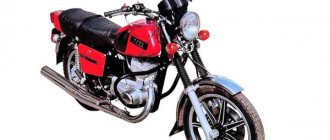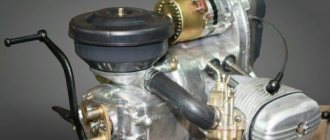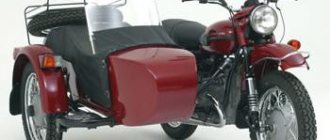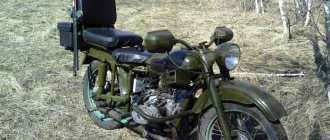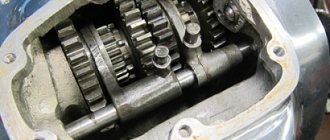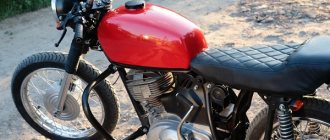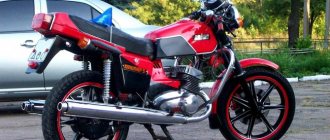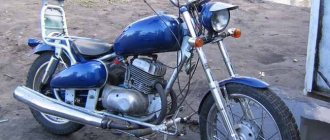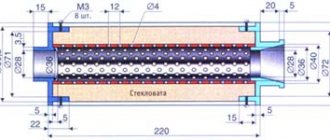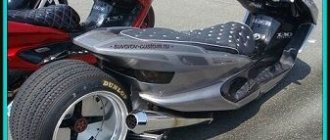The famous Java 250 motorcycle first appeared in 1972, and then all of Europe was able to see the skill of Russian specialists. In general, the production of 250 cc models from the plant in Czechoslovakia has always been successful, and the Java 250 is proof of this.
Today you are unlikely to see this motorcycle; it was produced for a short time - from 1972 to 1975. But if you were lucky enough to see this unit, consider yourself lucky, because back then it was a real symbol of the motorcycle industry. But any symbol has its own disadvantages and advantages.
Pros:
- reliable engine;
- low fuel consumption;
- stylish appearance.
Minuses:
- lack of details;
- it will be difficult for the buyer to find the motorcycle.
Technical characteristics of Java 250
In general, the Czechoslovak plant began producing 250 cc Java motorcycles back in 1935, so there is another unofficial name for the motorcycle - Java 250 old lady. Today they produce completely different equipment, but the previous serial Javas were made conscientiously and therefore residents of the CIS can still ride such a motorcycle. Let's look at the main characteristics of the serially produced Java 250.
The motorcycle is positioned as a two-seater, and to ensure good performance, an excellent engine with a capacity of 12 to 17 horsepower was installed, depending on the year of manufacture. Accordingly, the curb weight had an excellent indicator - up to 150 kg, and the maximum speed did not exceed 115 km/h. Thus, any owner of this model could easily move both along the highway at high speed and transport heavy loads in rural areas. And with the help of a 15-liter gas tank, the owner could go on a short trip.
The excellent safety of the motorcycle is also considered a big plus; it is equipped with wheels of a standard diameter of 18 inches, which in turn have reliable drum brakes. If you drive at high speed or for a long time, the air cooling system will protect the engine from overheating. An interesting and one of the best characteristics for Java 250 is the “Port control” distribution system.
Technical and operational characteristics of jawa 350 638
Jawa 350 638 has the following technical characteristics:
- Overall dimensions - 2110x750x1070 mm.
- Seat height - 810 mm.
- Ground clearance is 130 mm.
- Wheelbase - 1335 mm.
- Weight without fuel - 156 kg.
- Engine type: 2-cylinder, 2-stroke.
- Engine capacity - 350 cubic meters. mm.
- Power - 26 hp
- Tank volume - 17 l.
- Maximum speed is 130 km/h.
The fuel consumption of the Java 350 638 motorcycle is about 6-7 liters per hundred, which is a pretty good indicator for this class of motorcycle of that time, because only Japanese motorcycles, which are much more expensive, gave similar results.
Smooth running was achieved by a 4-speed gearbox consisting of three main shafts. The steering function was a conventional Java 638 telescopic fork. The electrical circuit of the motorcycle is based on a 12V circuit. Generator Java 638 with a power of 210 W, at 14V and 15A at 5000 rpm.
The Java 638 carburetor is a float carburetor with a central chamber equipped with a device for easy engine starting. When operating a motorcycle, it is necessary to pay due attention to the Java 638 crankshaft, because due to insufficient lubrication, this is a rather vulnerable part of the motorcycle.
Motorcycle review
In appearance you can see an excellent motorcycle with a simple but at the same time thoughtful design. The design of the motorcycle is made with special smooth transitions, and the red color adds charm.
If we return to the technical characteristics of the motorcycle, we can note a number of other positive details. For example, the engine had an excellent compression ratio at that time, which was 9.3. To accelerate as smoothly and comfortably as possible, engineers installed a manual gearbox at 4 speeds.
The first modification immediately received positive reviews; the Java 250 design and strong components made it possible to use the initial production technology in subsequent modifications, so only small elements were further modified. Soon a modification appeared with a modified angle of the box and engine. Manufacturers claim that this has made the engine more powerful and reliable. Today, it is quite difficult to find spare parts for the Java 250 ; there are not as many owners of this motorcycle in Russia as we would like, so you can only buy used spare parts.
Also today in the motorcycle markets you can find a new motorcycle called “Java 250”, but now this is not the same Java at all - the new items are positioned as off-road or cross-country versions. Buying a working Java 250 in good condition will be quite problematic. If you find someone who wants to sell a motorcycle, be prepared to pay from 30 to 100 thousand rubles for it; the model now costs a lot of money. And if you find such a model, be sure to sell it or restore it; the driving pleasure will be unsurpassed even today. And the appearance will be the envy of other modern representatives of similar motorcycles.
tuning Java 250
Despite their service life of approximately 30 years, today's old ladies can compete with other motorcycles of the Soviet Union, such as the new Ural, old Minsk or Dnepr motorcycles. Often the motorcycle is liked by experienced bikers and those who have already experienced its power and excellent characteristics.
Sports option
Tuning for sports, due to the technical features of Java, is the most common way of modifying it.
Basic requirements for sports motorcycles:
- Maximum speed.
- Acceleration speed.
- Controllability.
- Safety.
- Convenience.
One of the obvious disadvantages of the Java 350 is considered by many to be too light a front end, which begins to lose traction at high speeds. Therefore, despite the need for a general lightweight design, when installing a sports front fork, it will not be superfluous to place a counterweight. Changes to the chassis also include the installation of disc brakes, alloy wheels and a more wear-resistant chain from IZh motorcycles.
The performance characteristics of the Java 350 are largely relevant to this day, but the modernity of its design is a big question. The simplest option for external tuning for sports is to install parts from the Yamaha FZR400 and Kawasaki KR250 on a motorcycle. The first option is an excellent donor for the front wing, the second - for wheels, front forks and brakes, rear shock absorber and pendulum.
The last part for installation in the Java socket must be narrowed by replacing the standard bearings with needle bearings from the Volga pins. The combination of these innovations makes the motorcycle more maneuverable, stable and controllable. Body kits are made to order, both in workshops and by “home” craftsmen. Do-it-yourself external tuning of Java is also not uncommon. To do this, it is enough to be attentive and careful, and also to have a sufficient amount of plastic or fiberglass with you.
Exhaust system improvement
Another significant thing in tuning the Java 350 is the exhaust system. Unlike a 4-stroke engine, in a 2-stroke engine the cylinder is filled by purging the cylinder. With a properly assembled resonator, a fresh fuel mixture effectively fills the cylinder, and due to the conicity of the resonator, the sound wave is reflected. Thus, part of the mixture does not fly out into the pipe, but returning to the cylinder gives up to 20% more power. You can weld such a resonator with your own hands from sheet steel 0.6-0.8 mm thick, and argon or semi-automatic welding is recommended. The exhaust pipe of the resonator can be made by shortening the standard one by increasing the cone according to the drawing:
According to the figure, the engine will have a sharp pickup and increase in power around 5000 rpm. The damping nozzle is not necessary and only performs a noise-absorbing function. As with tuning the Voskhod motorcycle, this resonator can be used in the same way.
The significant mass of the crankshaft has high inertia, which is done for smooth operation of the engine. By lightening it, you can achieve a sharp response to gas and improved acceleration dynamics. Keep in mind that with this modification of the engine, it is extremely reluctant to operate at idle and low speeds. And of course, don’t forget about replacing the ignition from a contact system to an electronic microprocessor system.
“Boring” a Java engine
Upgrading the Java 350 engine with your own hands is only possible if you know how to work on various machines. To carry out work to increase power, it is necessary to dismantle and completely disassemble the engine. Next, examine the condition of the gearbox and gearbox parts; if they are severely worn, further modifications to the engine will be of no use. After inspection, you should begin polishing the purge, inlet and outlet channels.
After this, it is necessary to remove the jumpers at the bottom of the piston “windows”, and the piston pin skirt can be ground down to a cone. It is also advisable to polish the piston crowns so that less carbon deposits are deposited on it. To increase the compression ratio, it is necessary to trim the heads of all cylinders by 1.5-2 millimeters. After this, the load on the crankshaft will increase during engine operation. If the work is carried out correctly, the power of the Java two-stroke engine can be increased to 23-24 horsepower.
Trimming the cylinder heads of a Java 350 motorcycle
The large mass of the standard crankshaft is necessary for greater load capacity of the bike and maintaining stable idle speed, but this circumstance has a negative effect on the dynamics.
After repressing, there may be dips at idle, but acceleration dynamics will improve. To lighten the crankshaft, it is necessary to use turning, milling and boring machines. It is better to replace the bushings of the lower connecting rods after repressing the crankshaft, especially if they are already quite worn.
Replacing the bushings of the lower connecting rods of the Java 350 motorcycle
The final part of the tuning is to redo the ignition of the Java 350 motorcycle. Experts recommend completely replacing the entire system with a dual-circuit system from a VAZ 2108 with a hall sensor. It is best to replace the factory carburetor with an analogue from the Jawa 638 version, for which it will be necessary to make a special adapter. And remember that you can use the updated power “to its fullest” only after high-quality fine-tuning of the brakes and balancing.
Extraordinary JAWA tuning in action!
Here, too, I simply have no words. On the one hand, most of the motorcycle is kept original - the lower part. The pipes are shiny, no oil is leaking from them, good tires are installed, the engine is clean
. Most likely, technically everything is fine with this motorcycle, but why “decorate” it like that?
I remember as a child I was perplexed when I saw motorcycles passing by, whose seats were covered with some kind of skin, carpet, fur coat or something like that. Is this really convenient?
What's wrong with standard casing? Even if it was in short supply, is it really impossible to use another, more suitable material?
Well, I’m generally silent about the fairing. The solution with lighting devices is strange, in my opinion. At the very least, very extraordinary. And yet it is not clear why he was wrapped in a rag. Probably to match the seat.
That's all, let's wrap it up. Rate this publication
, if she was interesting to you.
There is no need to talk about benefits here. How do you like this format?
Don't forget
to subscribe
and good luck to everyone on the roads!
Updated appearance and improved chassis
You can modernize the appearance of the Java 350 motorcycle in different ways. Some are not satisfied with the original design and want to add sporting features to the bike, others are engaged in more practical improvements, such as reworking the front fork, lengthening the frame, installing new rims, a new disc brake clutch, etc. As a result of these changes the motorcycle becomes lighter and more maneuverable.
To replace the front fork and other chassis and exterior elements, Japanese spare parts from motorcycle models such as the Yamaha FZR 400 or Kawasaki KR200 are suitable. Some Java owners are replacing the rear swingarm with a part from Kawasaki. To do this, the frame in the area of the air filter is redesigned, the part itself is narrowed, and Japanese bearings are replaced with analogues from some VAZ models. The rear of the bike can be raised using shock absorbers from the IZH Planet 5 model. For a more “aggressive” sound, you can make a forward flow with your own hands.
To do muffler tuning on a Java 350, you must have:
- stock exhaust pipes from the model with the 638 engine
- steel sheet 0.8 mm thick
- metal scissors and welding machine
Tuning the muffler of the Java 350 motorcycle
The dimensions of the new resonator should be calculated so that the cone-shaped rear part is opposite the rear shock absorber mount, if the original pendulum is in the rear part and the frame has not been extended. The muffling parts of the direct flow should be made of sheet metal in the shape of cones, which turn into cylindrical “cans” filled with glass wool.
Addition
Tuning Java 350 very often affects the exhaust system. Despite contraindications from specialists, many owners install forward flow systems made from VAZ 2131 mufflers on this motorcycle; 21213; 21214. The part of the pipe leading to the engine is cut 5 cm from the muffler itself, and the part going out is bent at the required angle. When connecting to the elbow, the pipe is slightly cut and pressed tightly. The body mount is first welded to the forward flow, and a footrest is finally mounted on the motorcycle itself.
A tachometer will add to the presentation and functionality of the unit. Its connection is made according to the same parameters as in the car. Installing a starter on a Java 350 is a rather complicated procedure, but quite realistic. It requires a flywheel change, additional mounting on the body and a reinforced battery.
Motorcycle lighting is another characteristic manifestation of sports tuning. LEDs, the color of which can either emphasize the color of the device or be in contrast with it, illuminate key design components: the engine, exhaust pipe, rims.
Correctly performed tuning can not only transform your two-wheeled friend, but also significantly improve its technical parameters, making the motorcycle the envy of surrounding motorcyclists.
Engine tuning Java 350
The first thing the owners of the “old lady” strive for is improving its speed performance. A common misconception in this regard is the need to equip a motorcycle with a 5-speed gearbox . Its installation can be partially justified only if the chassis and engine are modernized. Boosting the engine is a guaranteed increase in maximum speed and acceleration, but there are a couple of nuances here. Firstly, boring the cylinders leads to a decrease in the thickness of their walls, and, consequently, to an increase in heat transfer, which entails a loss of compression and possible jamming.
Secondly, forcing implies the combustion of more fuel in one cycle, which means increased fuel consumption and thermal stress of parts.
Therefore, in the case of boring, water or intensive forced cooling should be installed on the jackets and cylinder heads. It is also necessary to replace or reconfigure the carburetor to suit the increased “appetite” of the engine. Installing an electronic ignition from a VAZ 2106 will make the engine more playful, reduce vibration and reduce fuel consumption.
